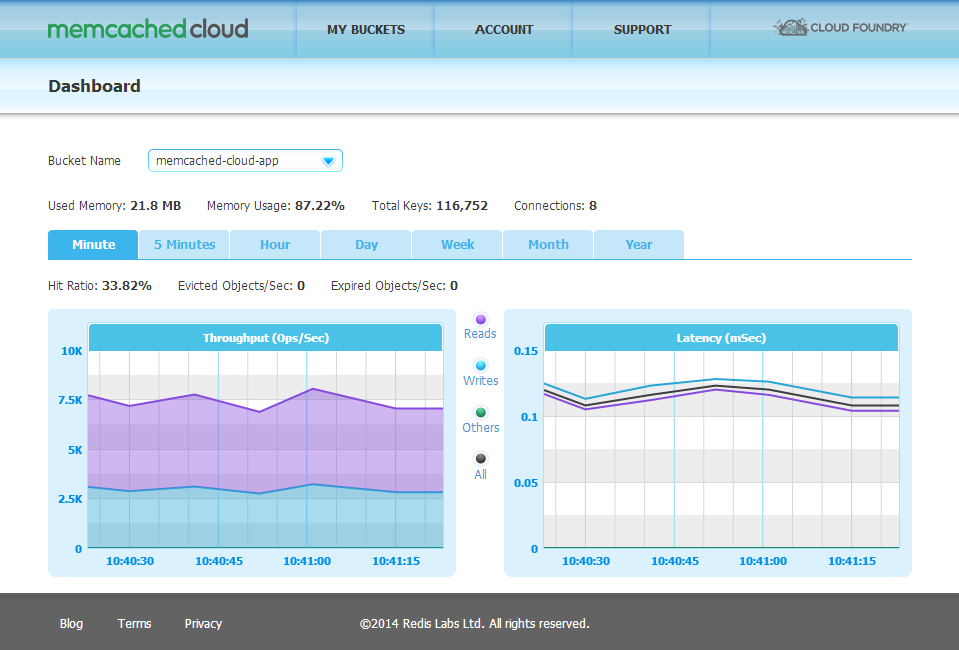Memcached Cloud is a fully-managed service for running your Memcached in a reliable and fail-safe manner. Your dataset is constantly replicated, so if a node fails, an auto-switchover mechanism guarantees data is served without interruption. Memcached Cloud provides various data persistence options as well as remote backups for disaster recovery purposes. You can quickly and easily get your apps up and running with Memcached Cloud through its through its App Service add-on at Azure Store - just tell us how much memory you need and get started instantly with your first Memcached bucket.
A Memcached bucket is created in seconds and from that moment on, all operations are fully-automated. The service completely frees developers from dealing with nodes, clusters, server lists, scaling and failure recovery, while guaranteeing absolutely no data loss.
Choose the Memcached Cloud add-on from the Azure Store's App Service catalog, select your plan and set a unique name for your resource, approve your purchase and you're done.
On your Azure add-ons console, wait for your Memcached Cloud service to be started. Then, simply click on your service's Connection Info and get your Memcached Cloud host, port, usernamer and password.
Dalli is a high performance pure Ruby client for accessing memcached servers, which uses the binary protocol.
For usage with Rails 3.x, update the Gemfile:
gem 'dalli'
And then install the gem via Bundler:
bundle install
Lastly, in your config/environments/production.rb:
config.cache_store = :dalli_store, "<your_memcached_cloud_host>:<your_memcached_cloud_port>".split(','), { :username => "<your_memcached_cloud_username>", :password => "<your_memcached_cloud_password>" }
Add this code snippet to your configure block:
configure do
. . .
require 'dalli'
$cache = Dalli::Client.new("<your_memcached_cloud_host>:<your_memcached_cloud_port>".split(','), :username => "<your_memcached_cloud_username>", :password => "<your_memcached_cloud_password>")
. . .
end
No special setup is required when using Memcached Cloud with a Unicorn server. For Rails apps on Unicorn, follow the instructions in the Configuring Memcached from Rails section and for Sinatra apps on Unicorn see Configuring Memcached on Sinatra section.
$cache.set("foo", "bar")
# => true
$cache.get("foo")
# => "bar"
spymemcached is a simple, asynchronous, single-threaded memcached client written in Java. You can download the latest build from: https://code.google.com/p/spymemcached/downloads/list.
To use the maven repository, start by specifying the repository:
<repositories>
<repository>
<id>spy</id>
<name>Spy Repository</name>
<layout>default</layout>
<url>http://files.couchbase.com/maven2/</url>
<snapshots>
<enabled>false</enabled>
</snapshots>
</repository>
</repositories>
And specify the actual artifact as follows:
<dependency>
<groupId>spy</groupId>
<artifactId>spymemcached</artifactId>
<version>2.8.9</version>
<scope>provided</scope>
</dependency>
Configure the connection to your Memcached Cloud service using your Connection Info and the following code snippet:
try {
// building the memcached client
AuthDescriptor ad = new AuthDescriptor(new String[] { "PLAIN" },
new PlainCallbackHandler("<your_memcached_cloud_username>", "<your_memcached_cloud_password>"));
MemcachedClient mc = new MemcachedClient(
new ConnectionFactoryBuilder()
.setProtocol(ConnectionFactoryBuilder.Protocol.BINARY)
.setAuthDescriptor(ad).build(),
AddrUtil.getAddresses("<your_memcached_cloud_host>:<your_memcached_cloud_port>"));
} catch (IOException ex) {
// the memcached client could not be initialized.
}
mc.set("foo", 0, "bar");
Object value = mc.get("foo");
bmemcached is a pure, thread safe, python module to access memcached via its binary protocol.
Use pip to install it:
pip install python-binary-memcached
Configure the connection to your Memcached Cloud service using your Connection Info and the following code snippet:
import os
import urlparse
import bmemcached
import json
mc = bmemcached.Client("<your_memcached_cloud_host>:<your_memcached_cloud_port>".split(',').split(','), "<your_memcached_cloud_username>", "<your_memcached_cloud_password>")
mc.set('foo', 'bar')
print client.get('foo')
Memcached can be used as a django cache backend, with django-bmemcached.
To do so, install django-bmemcached:
pip install django-bmemcached
Next, configure your CACHES in the settings.py file:
import os
import urlparse
import json
CACHES = {
'default': {
'BACKEND': 'django_bmemcached.memcached.BMemcached',
'LOCATION': "<your_memcached_cloud_host>:<your_memcached_cloud_port>".split(','),
'OPTIONS': {
'username': "<your_memcached_cloud_username>",
'password': "<your_memcached_cloud_password>"
}
}
}
from django.core.cache import cache
cache.set("foo", "bar")
print cache.get("foo")
PHPMemcacheSASL is a simple PHP class with SASL support.
Include the class in your project, and configure a connection to your Memcached Cloud service using your Connection Info with the following code snippet:
<?php
include('MemcacheSASL.php');
$mc = new MemcacheSASL;
$mc->addServer("<your_memcached_cloud_host>", "<your_memcached_cloud_port>");
$mc->setSaslAuthData("<your_memcached_cloud_username>", "<your_memcached_cloud_password>");
$mc->add("foo", "bar");
echo $mc->get("foo");
Our dashboard presents all performance and usage metrics of your Memcached Cloud service on a single screen, as shown below:
To access your Memcached Cloud dashboard, simply click on your service's 'Manage' button in your Azure add-ons console.
You can then find your dashboard under the MY DATABASES menu.
Any Memcached Cloud support issues or product feedbacks are welcome via email at support@redislabs.com.
